Liberty Gold Double Eagles

 Liberty Double Eagles - available in 3 main design types
Liberty Double Eagles - available in 3 main design types
The Liberty Gold Double Eagles are one type of the different pre-1933 U.S. gold coins that are still actively traded today. Almost 104 million Liberty Double Eagles had been minted by the US Mint between 1849 and 1907 at its branches in Philadelphia, New Orleans, San Francisco, Carson City and Denver. The Liberty version of the Double Eagles was succeeded by the $20 Saint-Gaudens Gold Double Eagles in 1907.
The Gold Double Eagles were made of 90% gold and 10% copper with each coin containing 0.9675 oz of gold. The obverse side of the coins shows a leftward facing Lady Liberty in profile. An eagle that is holding a shield can be seen on the reverse. Collectors that prefer to buy gold coins with a proof finish would have to pay very high premiums for the proof version of the Liberty Double Eagle coins since the US Mint in Philadelphia only produced a very small number of such coins.
Besides the three main subtypes that exist of the Liberty Head version of the Double Eagle coins, there exist many additional coin variations and the differences can be subtle. Some of these variations like the coins with the modified Paquet reverse are very rare gold coins that are highly sought after by collectors. American buyers that are investing in gold for their retirement should take note that the coins are not eligible for inclusion in Individual Retirement Accounts (IRA's) since they are classified as collectible gold coins by the IRS.
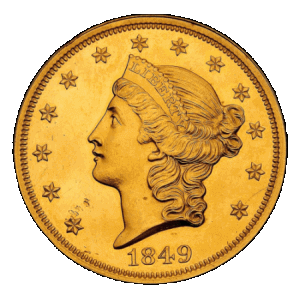
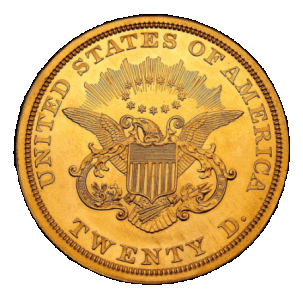
Coin Fact Sheet
| Weight | Face Value | Purity | Diameter |
|---|---|---|---|
| 0.9675 oz | US $ 20 | 90% | 34 mm |
Total Mintage: 103,822,180
Double Eagle Coin Design
The original design of the Liberty Gold Double Eagle underwent two major changes over the years of its production. Therefore, we can distinguish three subtypes. Type I was minted from 1850 - 1866, Type II from 1866 - 1876 and Type III from 1877 - 1907.
Original Type I Design
The obverse side depicts a leftward facing Lady Liberty in profile in the style of Greco-Roman sculptures. She wears a pearl crown that has "LIBERTY" inscribed on it. Thirteen stars appear along the outer edges of the coin, representing the 13 original colonies of the United States of America. The year of mintage is inscribed underneath Lady Liberty's portrait. The image above shows the 1849 proof coin that apart from its finish is identical in design to the Type I coins.
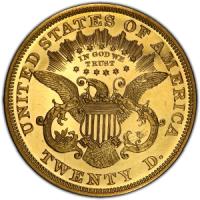
The motif on the reverse side of the $20 Liberty Double Eagle is derived from the Great Seal of the United States. It shows an eagle with a shield holding an olive branch and arrows. "E PLURIBUS UNUM" is inscribed on a double banner that the eagle is holding up left and right. Thirteen stars appear as a halo together with an arc of rays above the eagle's head. The coin's $20 denomination (TWENTY D.) and “UNITED STATES OF AMERICA” are engraved along the coin's edge. Gold Double Eagle coins that were minted in New Orleans (mintmark: O), San Francisco (mintmark: S), Carson City (mintmark: CC) or Denver (mintmark: D) contain a mintmark just above the denomination. However, coins that were minted at the main Philadelphia branch of the United States Mint don't have any mintmark.
Type II Design Changes
The production of the Type II version of the coin started in 1866.
The most noticeable change was the addition of the motto “IN GOD WE TRUST” within the enlarged circle of stars on the reverse side.
The other changes are less noticeable and affected the sides of the eagle's shield, the eagle's wings and tail feathers, the olive branch and the inscription "E PLURIBUS UNUM".
Type III Design Changes
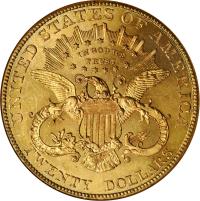
The Type III Liberty Double Eagle gold coins were produced from 1877 until the end of mintage in 1907.
The inscription of the denomination on the reverse side was changed from "TWENTY D." to "TWENTY DOLLARS". Furthermore, the motto "IN GOD WE TRUST" was inscribed in bolder font and "E PLURIBUS UNUM" was enlarged. Other minor changes were made to the depiction of Lady Liberty's neck and her pearl crown.
In 1900, some hardly perceptible design alterations were made as well, for example the smoothing of the back of the eagle's neck.
History of the Liberty Double Eagle coins
Due to the California Gold Rush in the 1840's which greatly enhanced the amount of gold circulating within the economy, the American Congress approved new denominations of gold coins to be issued. The Liberty Double Eagle coin was one of two newly issued gold coins (the Type 1 Liberty Gold Dollar was the other). Production lasted from 1849 until 1907.
Chief Engraver James B. Longacre of the Philadelphia Mint designed the Liberty Double Eagle gold coin. Only two or three coins were struck in 1849 as pattern coins in proof condition. Out of those, only one is known to have survived and is now on display at the National Numismatic Collection at the Smithsonian.
Commercial minting of the $20 Liberty Gold Double Eagles (Type I) started in 1850 at the mint facilities in Philadelphia and New Orleans. The Type II design coins with the added motto "IN GOD WE TRUST" were struck from 1866 until 1876. The Type II Gold Double Eagles were replaced by the Type III version in 1877. Some very slight design changes occurred again in 1900.
Even though production of the Liberty Double Eagles lasted from 1849 to 1907, only the US Mint in Philadelphia produced them every year during this period (albeit only as proofs in the years 1883, 1884, 1887).
In 1907, the $20 Saint-Gaudens Gold Double Eagles replaced the Liberty Head Gold Double Eagles.
Coin Variations
In 1861, Anthony C. Paquet modified the reverse side of the coins but only a limited number of these modified coins were minted in San Francisco (up to 1 month production of these modified coins) and Philadelphia (unknown mintage but 3 coins are known to exist) before the design reverted back to the original reverse.
Some of the coins that were minted in 1861 in New Orleans were struck under the authority of the breakaway State of Louisiana. However, they are visually undistinguishable from the standard coins.
Two variations exist of the coins that were minted in Philadelphia in 1854. The variation concerns the size of the date on the obverse side, so there exist coins with a larger and a smaller date. The numbers on the coins with the large date are much closer to the Liberty bust than on the small date coins.
Coins struck in 1873 exist with the last digit of the year minted as an "Open 3" or "Closed 3". The difference is hardly noticeable. The "Open 3" variation is far more common and the "Closed 3" variation nowadays quite scarce. According to coin expert Gordon Wrubel, the two varieties can be distinguished by closely looking at the ball at the extremity of the lower curve of the 3. On "Open 3" coins, the ball has about the same diameter as the opening of the 3 and would pass through it. On "Closed 3" coins, the opening is much narrower so that the ball could not pass through it.
Rare Dates
Aside from proof coins, the 1861 "Paquet" coins are undoubtedly the rarest issue of Liberty Double Eagle coins.
The coins minted in Philadelphia are hard to find for the year 1882 (571 coins) and 1886 (1,000 coins). The coins minted in New Orleans are rare for 1854 (3,250 coins), 1856 (2,250 coins) and 1879 (2,325 coins) and the coins minted in Carson City are rare for 1870 (3,789 coins) and 1871 (17,387 coins).
Severely limited numbers of proof coins were almost exclusively minted in Philadelphia. The exception to this rule is that a total of 7 proof coins were minted in Denver in 1906 and 1907 and 1 proof coin was minted in San Francisco in 1854. Annual proof mintage never exceeded a maximum of 158 coins.
A limited number of 1866 Liberty Double Eagle gold coins with the mintmark S (San Francisco) and without the motto “IN GOD WE TRUST” may still exist. The San Francisco branch mint switched production to the Type II design sometime in 1866 only after having used up their leftover reverse dies from 1865.
Mintage Numbers
Annual mintage of $20 Double Eagles at the various US Mint branches varied between 571 coins (Philadelphia 1882) and 6,256,699 coins (Philadelphia 1904). Proof coins were almost exclusively minted at the Philadelphia branch of the US Mint and proof mintage varied between 1 coin and 158 coins (1903). Liberty Head Double Eagles were only minted as proofs in 1883, 1884 and 1887.
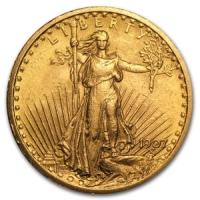
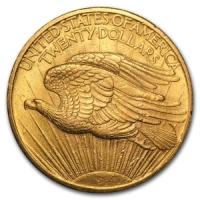
Saint-Gaudens Gold Double Eagles
The name of these coins refers to the US Mint sculptor Augustus Saint-Gaudens who designed them. The $20 Saint-Gaudens Gold Double Eagles succeeded the $20 Liberty Gold Double Eagles in 1907. The coins depict Lady Liberty on the obverse and a flying eagle with the sun on the reverse. The US Mint produced the new coins from 1907 to 1916 and then again from 1920 to 1933. The coins were struck at the US Mint facilities in Philadelphia, San Francisco and Denver. Their composition is 90% gold and 10% copper with each coin containing 0.9675 oz of gold. More than 70 million Saint-Gaudens Double Eagle coins were minted.
The Saint-Gaudens Gold Double Eagle page gives more information about the coins and allows you to compare current prices.